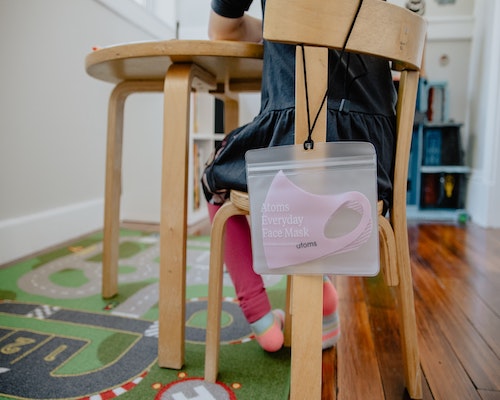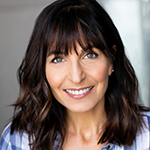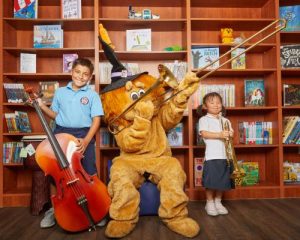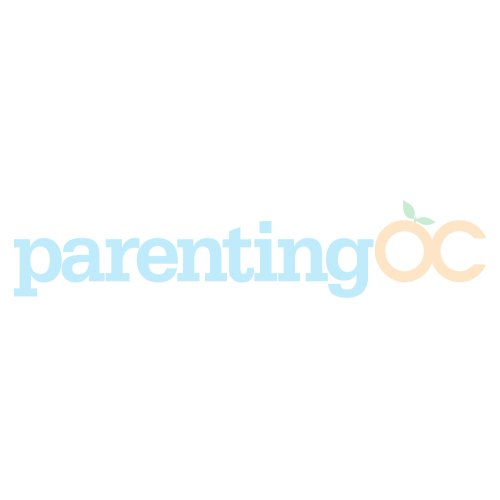When news of pandemics and school shootings create anxiety, and cyberbullying causes fear, artistic expression, and present-moment awareness can instill calm.
If the world feels more stressful to you than ever before, you’re not alone. COVID-19 and its unending variants, school shootings, cyberbullying, threats of nuclear war, climate catastrophes and a looming recession have us all on edge. So, it’s not surprising that many parents are unable to achieve a calm, present-moment awareness at any point during their day. Nor is it surprising that their children can feel that unease. But for them, there’s an additional stressor: back-to-school worries about making new friends and learning to re-socialize after two years of on-and-off school closures. For some children, the combination of stressors can become overwhelming. Yet there have generally been very few programs offering help.
Anthony Cupo was moved to change that 15 years ago in New Jersey, when his sister, Christine Robertello, a clinician, worried that a young client and his family with whom she worked twice a week, needed more support — but nothing was available. So, the brother-sister team began work on an intense behavioral modification program for children called Stepping Forward. Six years ago, they opened Stepping Forward in Orange County. It was the first Intensive Outpatient Mental Health Program for children in the county.
Turn Off Media, Turn On Mindfulness
A Trained Mindfulness Facilitator (TMF) from the UCLA Semel Institute for Neuroscience and Human Behavior, Cupo has seen many troublesome changes in the last 15 years.
“In the past when a kid was bullied, it didn’t follow them home. Now it does. There’s no sense of peace,” he says.
A recent University of Southern California study found that Americans are exposed to 13-plus hours of media a day on average, most of it filled with stimuli designed to trigger the amygdala (our fight-flight-or-freeze center). This onslaught of 24/7 “bad news” combined with social media pressures and back-to-school anxiety can cause a sort of paralysis from over-analysis for some children. There is simply too much information to process, resulting in a “freeze” response.
In addition to turning off the electronic devices, Cupo urges mindfulness practice to find peace, using the acronym STOP as an entry point: “Stop, Take a breath, Observe and Proceed.” By slowing down and incorporating their senses, children become instantly mindful.
“The mindfulness approach is just being curious about what is happening at that moment. Where there’s curiosity, there’s not a lot of judgment,” he says.
And where there’s not a lot of judgment, there’s not a lot of anxiety.
“Anxiety is always worry about the future,” Cupo says. A typical child using mindfulness techniques can lower the temperature of the anxiety, according to Cupo. It’s also important to communicate. A good trick for broaching anxiety-producing subjects with our children can be playing pretend.
“Maybe you pretend that it’s a friend’s child with a problem. In that pretend mode you’re disassociating so there’s less focus on the child, opening up more space for them to feel free to talk about things,” he says.
While Cupo stresses that he is not a clinician, he is certain of the value of mindfulness, having maintained his own daily meditation practice for 36 years.
“I like to say meditation and money have one thing in common: They both give you choices. Only money can’t make you happy, but meditation can.”
The Tone of Safety
“Every new school year brings nervous anticipation. ‘Will I make friends? Will my teachers like me?’ What’s new is that in addition to worries about ‘social death’ there are now added layers, worries of ‘physical death,’” says Joshua Townshend-Zellner, a Beverly Hills-based retreat leader, phenomenologist and creative coach who has worked with children and adults in the theater and film industry for over 25 years.
According to Townshend-Zellner, it’s incumbent on parents and teachers to make children feel safe. But when Townshend-Zellner attended his nephew’s fifth-grade graduation recently, he noticed fear in teachers’ voices.
“If you can’t access that feeling of safety, there’s no way it’s going to land with a child, especially a very sensitive child,” says Townshend-Zellner. And it’s usually the highly sensitive child who’s most prone to anxiety whether related to COVID-19, news of mass shootings, bullying or any other perceived threat.
“The problem is that up to a certain age, children only hear the tone of what you’re saying and many teachers I know hold a lot of fear. If you worked in that environment today, you’d be fearful too.”
However, this is counterproductive according to Townshend-Zellner. “Fear takes you out of the present moment. Your sensitivity plummets by design. You’re not noticing which way the wind blows when you’re running away from the tiger.” And that means frightened teachers are less apt to notice the child who is acting out in subtle ways in the classroom.
Once again creative mindfulness helps. Be curious about a child who suddenly begins biting his nails. As a teacher, ask the parents gently if there’s anything you can do to help. At home, notice that pungent smell and the crisp sizzle as you sauté the meatballs and garlic for supper. Focus on how centered and calm you become with that simple act. Regardless how crazy the world outside may be, you can focus on what’s OK in your own home.
“Yes, I’m going to make sure you have a safe time at school,” Townshend-Zellner says. “And when you come home, dinner will be waiting for you.” If we want our children to perform at the highest level whether in class, at home or on a soundstage, we have to make sure they feel safe.
Art as Medicine
Newport Beach-native Diana Shabtai, Psy.D., ATR-BC, has loved creating art since she was a child, and that passion led her to open a unique studio on the peninsula where she grew up. With a doctorate degree in Marriage and Family Therapy and credentials as a board-certified Clinical Art Therapist, Shabtai looked at the growing evidence from national studies that showed the therapeutic benefits of creating art. Engagement in specially designed arts activities or arts therapies can reduce physical symptoms and improve mental health issues. She began using art as a wellness tool nearly 20 years ago, and in 2012 Shabtai opened her Newport Beach-based Art Therapy OC, where she works with adults and children ages 3 and up. Shabtai is a lover of color, and that is on full display in her bright and eclectic space, color-splashed with vibrant murals. It’s a friendly place, and her studio dog Mr. Snickers helps see to that. Shabtai loves to see confidence bloom in a child while painting in her studio, but she also works with parents and even dementia and Alzheimer’s patients. During the pandemic, Shabtai noticed many children and their parents attending daily — painting, creating with crafts or sculpting with clay.
“The medium is different for everyone,” she says. “It depends on the child. Clay can help [to] uplift someone who is depressed by building the clay up. But it also can help the child who is anxious or has too much energy. They can smash it and reconstruct it.”
Creating art can be especially helpful for a shy child or for those who are limited with verbal expression. The process, according to Shabtai, calms the nervous system, promoting mindfulness and focus and reducing overstimulation from outside sources.
“It also increases self-esteem because you’ve created a beautiful piece of art,” she says. The day Parenting OC spoke with her, she was conducting a kids camp using fabric and paint, engaging the children’s tactile sense and their sense of smell.
“The pandemic changed things for many families,” says Shabtai, who found that many families have decided to continue home-schooling even as schools have reopened. And for those students who are returning to the classroom, “vision collages can help in setting goals and relieving anxiety that can come with the transition of a new school year,” she says.
Related Posts:
- Parents Are People Too! – Free Parent Zoom Workshops
- How to Navigate School During the COVID-19 Pandemic
- Schools and Families Reflect on Post-COVID Campuses
Bullying and Other Difficult Topics
Regine Muradian, PsyD., is a Glendale-based psychologist who works with LA-area and OC schools. She tests children and teens for ADHD, learning challenges and executive functioning. After an assessment is conducted, she goes to the school with the parents and advocates for the student’s accommodations. She also explains to teachers and administrators what a clinical diagnosis can look like in the classroom.
In 2021, she and a couple of other psychologists created training modules to educate teachers. The program, dubbed Team Project RISE, helps teachers identify depression, anxiety and disruptive behaviors while offering instructions on treatment.
Since COVID-19 and the school closures, Muradian is seeing more anxiety and shorter attention spans.
“There’s been a loss but kids are resilient,” she says. She acknowledges, however, that after two years of not exercising those learning and socializing muscles, there’s now an increase in social anxiety. “The school staff doesn’t always know how to recognize these signs or what to do about it.”
That’s where Team Project RISE can help.
Remarkably, Muradian and her team don’t charge for this service. “We tried to get a senator to sign off on the idea, but he didn’t so we decided we’d do it ourself.”
Muradian has been featured in national and regional magazines and on several TV news programs reminding parents and educators of the importance of making our children feel safe, including when it comes to bullying.
“I hear all the time from kids getting intentionally hurt on the playground,” she says. If parents suspect bullying, Muradian wants them to do two things:
“First commend your child for coming to you. Validate what they’re feeling. Don’t dismiss it.” Oftentimes a child can feel like they did something wrong, which obviously is not the case.
And second, address the issue with the school immediately, she warns, “Otherwise nothing will get done.” She advises going in person and talking to the administration with an open heart. “Perhaps you can say to the principal, ‘I want to share something with you. …You’re a parent too, right?’”
One Newport Beach mother, Ann Markell, recalls doing just that when her son was bullied in middle school. “I talked to the principal and asked that something be done. When nothing happened, I went back the next month and demanded that the other child be removed from the classroom, and eventually he was.”
While such demands may work for some, Muradian urges parents to first adopt a gentler approach by putting themselves in the administrator’s shoes. It’s also very important to create a nightly conversation with our children about how their day went. If they don’t feel like talking, don’t press it, she says.
“Instead, reassure them that you’re always there. Today’s kids need to feel safe, so consistency is key. And don’t expose them to too much media.”
When asked how young is too young to broach difficult topics such as school shootings, drug use or sexual activity, she says not to go into too much detail. Questions are more powerful. Ask them how much they know first, or wait for them to bring up the topic.
“Because they have so much at their fingertips, they can find out about anything they want. So as young as 8 or 10 we have to have very open discussions. If your son says, ‘I’m erect when I wake up in the morning…’ I would say 10 is too young to discuss that unless he is the one who brings it up.”
Addressing Mental Health
Janeane Bernstein, ED.D., is a mental health advocate, author and radio host. She earned a doctorate from Boston University. In 2011, she started “Get the Funk Out!” on KUCI 88.9 FM: UC Irvine after losing her childhood friend. She’s also the mother of two daughters, ages 20 and 23.
“My younger daughter has gone through many challenges during the pandemic,” she says. When Bernstein’s daughter would tell her that she didn’t understand what it was like to have no prom or graduation, Bernstein would agree.
“She was right. I didn’t know what that was like.” But Bernstein’s always been a big believer in the creative arts as a way to connect and as a tool for mental wellness, so she suggested her daughter take an art class.
“She brought home this beautiful bust that she sculpted and she’s since become a psychology major, and I’m so proud of her.”
In 2020, Bernstein also suggested her daughter get a job in her community.
“It’s been a game-changer for her. One of the best things she did. You can’t push your kids, but you can give them a menu. Make suggestions.”
Bernstein is currently working on her second book, “Better Humans — What the Mental Health Pandemic Teaches Us About Humanity.” She strongly advocates for mental health programs in schools.
“We’re taught STEM, but never anything about mental health. Where are the peer-to-peer programs for kids?”
Referencing the various warning signs we’ve learned about the Uvalde shooter, Bernstein urges schools to institute preventative programs.
“Shouldn’t the students have somewhere to go?”
5 Tips for Easing Back-to-School Social Anxiety
- Share the Fear. Encourage your child to share his or her fears. Ask your child what is making him or her worried. Tell your child that it is normal to have concerns. Before and during the first few weeks of school, set up a regular time and place to talk.
- Practice empathy. Remind them that others feel the same way. Suggest that they find ways to make other kids feel more comfortable. Maybe they focus on helping one child who seems scared.
- Connect. Suggest that they find a student club or a school sport team to join as a way to connect.
- Manifest. Create a vision board with all the goals they hope to achieve, both scholastic and social.
- Be cool. Don’t be overly solicitous, however. You don’t want them to feel your concern and interpret that as a lack of confidence. You also don’t want them to have “paralysis from over-analysis” due to too much info and too many tips. Be cool and remind them that you were a kid once too. And sometimes it’s uncomfortable, but that’s OK. It won’t last.
Joni Ravenna is an award-winning playwright, journalist and co-author of “You Let Some GIRL Beat You?”















Leave a Reply